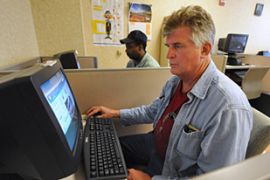US unemployment rate soars
Unemployment tops 10 per cent but number of job cuts falls, official data reveals.

Christina Romer, the chairwoman of the White House Council of Economic Advisors, said the jump in unemployment from 9.8 per cent in September reflects the typical lag shown by the labour market as growth picks up.
“Today’s employment report contained both signs of hope for recovery and painful evidence of continued labour market weakness,” she said in a statement.
The largest job losses over the month were in construction, manufacturing, and retail trade.
Well-worn path
Max Fraad Wolff, an economics professor at New School University in New York, said Obama’s news conference was “more or less travelling down the same well-worn path, with the possible exception of one good piece of news” – the 20-week extension in unemployment benefits.
“Behind those headline numbers, which are pretty shocking and upsetting in of themselves, is the fact that a little more than 35 per cent of the unemployed in America have been unemployed for six months or more and they are beginning to run out of their unemployment benefits,” he told Al Jazeera.
| California crisis |
|
|
“President Obama has signed an extension to those benefits today.”
While the official US unemployed rate has gone into double digits, Wolff said that the real jobless rate was even higher.
“We get a number called U3 from the Bureau of Labour Statistics – that is the official unemployment level. The real unemployment level is more like something called U6 – and that stands at 17.5 per cent,” he said.
“These are massive unemployment figures … they tell us that no neighbourhood, no sector, no town, no community does not face the weight or feel the sorrow of unemployment.”
Tom Bemis of Marketwatch.com in London, told Al Jazeera that the US economy had grown in the last quarter and that the US productivity rate “shot up quite a bit”.
“That’s typical when you’re trying to come out of the end of a recession as it is hoped now,” he said.
Long-term unemployed
Bemis said the problem is that the long-term unemployed, those who have been out of a job for more than six months, continues to grow and it is up past 5.5 million now.
“If those people remain unemployed for a long time, their ability to consume is impaired and the ability to kickstart the US economy is in serious question,” he said.
Commenting on the October figures, Robert MacIntosh, an economist at Eaton Vance, said: “The employment numbers themselves when you look at the revisions weren’t all that bad, but the headline of 10 per cent was huge psychologically.”
MacIntosh said that if current trends continue, the economy could see job gains in January or February but that unemployment may rise with labour force and population growth.

 Video: Elderly hit hard by healthcare cuts
Video: Elderly hit hard by healthcare cuts